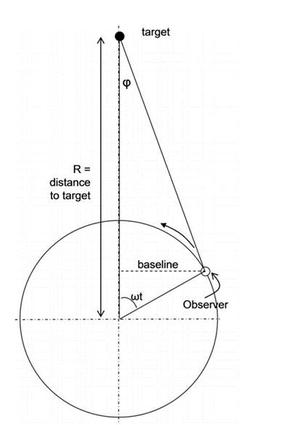Glossary term: Parallax
Description: Parallax is the apparent change in position of a celestial object on the sky due to a change in the observer’s point of view. The position change in the sky, expressed as an angle, is determined relative to the most distant objects we know – historically, distant stars; in modern astronomy, extremely distant objects called quasars, which determine what is called the International Celestial Reference Frame. The angle of apparent position change is inversely proportional to the object's distance from us, making parallax measurements a powerful tool for determining distances in our cosmic neighborhood ("parallax method"). For Solar System objects, simultaneous observations from different locations on Earth can yield useful parallax values. For stars, parallax angles are given for a standard shift of observer position by one astronomical unit (the average Earth–Sun distance) at right angles to the line of sight. Observer position shifts of that magnitude can be achieved by making observations several months apart, with Earth moving along its orbit around the Sun in between. By definition, an object whose parallax angle under those conditions is 1 arcsecond is at a distance of 1 parsec (3.26 light years) from Earth. Over one year, the apparent position of a star in the sky traces out an ellipse, whose semi-major axis is the parallax angle. The most accurate stellar parallaxes to date are supplied by ESA's Gaia mission, a space telescope specifically designed for that task.
Related Terms:
See this term in other languages
Term and definition status: This term and its definition have been approved by a research astronomer and a teacher
The OAE Multilingual Glossary is a project of the IAU Office of Astronomy for Education (OAE) in collaboration with the IAU Office of Astronomy Outreach (OAO). The terms and definitions were chosen, written and reviewed by a collective effort from the OAE, the OAE Centers and Nodes, the OAE National Astronomy Education Coordinators (NAECs) and other volunteers. You can find a full list of credits here. All glossary terms and their definitions are released under a Creative Commons CC BY-4.0 license and should be credited to "IAU OAE".
Related Activities
The 4-Point Backyard Diurnal Parallax Method
astroEDU educational activity (links to astroEDU website) Description: Measure the distance to an asteroid with a novel techniqueLicense: CC-BY-4.0 Creative Commons Attribution 4.0 International (CC BY 4.0) icons
Tags: Hands-on , Measurement , Distances , CCD imaging , astrometry Age Ranges: 16-19 , 19+ Education Level: Informal , Secondary , University Areas of Learning: Guided-discovery learning , Project-based learning Costs: High Cost Duration: several days Group Size: Group Skills: Analysing and interpreting data , Asking questions , Communicating information , Constructing explanations , Planning and carrying out investigations , Using mathematics and computational thinking








